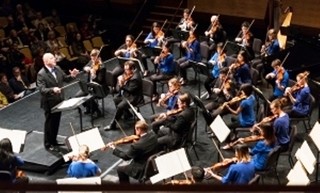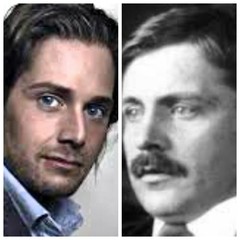|
Back
Schoeck Treatment! New York
Stern Auditorium, Carnegie Hall
11/14/2019 -
Arthur Honegger: Rugby, H. 67
Othmar Schoeck: Lebendig Begraben
Dimitri Mitropoulos: Concerto Grosso
Igor Stravinsky: Divertimento, Symphonic Suite from the Ballet “Le Baiser de la fée”
Michael Nagy (Baritone)
The Orchestra Now (TŌN), Leon Botstein (Founder, Musical Director, Conductor)

L. Botstein and TŌN (© The Orchestra Now)
“ Now have I fed and eaten up the rose/Which she laid in my stiffcold hand./That I should ever feeed upon a rose, I never had believed in liveman’s land./Only I wonder whether it was white or red/The flower that in the darkness my food has been./Give us, and if Thou give Thy daily bread. Deliver us from evil, Lord, Amen.”
Gottfried Keller, from poems for Buried Alive, translated by James Joyce
“ Only life suffered can transform a symphony from a collection of notes into a message of humanity.”
Dimitri Mitropoulos (1896-1960)
It was typical Botstein adventurous chutzpah, starting a concert with a rollicking eight-minute tribute to life, liveliness, and velocity. And a minute later, offering a song-cycle about a man accidentally entombed, enshrining his last desperate 42 minutes hoping hopelessly for rescue. We in the audience felt our feelings bouncing like Arthur Honegger’s rugby ball.
The second half was united not by date of composition (all four works last night were written between 1928-1929). Nor that one was composed by a mediocre writer and a futuristic conductor; and the other written by a mediocre (if precise) conductor and probably the greatest composer of the last century.
The link was, instead, that both Dimitri Mitropolous and Igor Stravinsky were linked by their descent from the Byzantine Orthodox Church.
Leon Botstein was at his best with his international youth orchestra. Though rarely (I am thinking of the first draggy movements of the Mitropoulos Concerto Grosso) could they overcome middling writing. Mitropoulos’ younger days with songs like Kassiani reviewed recently, were far better.
Otherwise, we had terrific ensemble writing in Buried Alive, some super contrapuntal dazzlement in the Honegger Rugby, and spot-on rhythmical dynamics in The Fairy’s KissBaiser de la fée.
Arthur Honegger’s Rugby was last played in New York 57 years ago. And little of this composer has been played since. It’s something of a shame that he is now paired with Les Six, since the French-born Swiss artist had produced so many truly serious works, especially with poet Paul Claudel.
Rugby could be conceived as a piece of sheer virtuosity–but sheer velocity is a better term. To use such a difficult work as a beginning for this concert might not have been fair. But Mr. Botstein took his TŌN group through the “game” with no problems, in fact with a literally breathless finish.
(By the way, Rugby was premiered during the half-time of a France-London rugby game. Could you imagine the same thing happening in America?
(“And now, ladies and gentlemen, for the SuperBowl Halftime, we’ve decided to shuck Taylor Swift and Beyoncé. Instead the JACK Quartet will play two Morton Feldman string quartets, and finish up with Elliott Carter’s “Elegy for Viola and Piano”. Crowd: “Hurrah! Hurrah U! S! A!, U! S! A!”)

M. Nagy/O. Schoeck
Mr. Botstein–whose customary eclectic encyclopedic program notes were badly missed–is rightly famed for digging up rare music. While this rarity is frequently well-deserved, the American premiere of Othmar Schoeck’s Buried Alive is one of the most resplendent, rare, massive pieces, in time, resources, and emotions I had ever heard.
This was not Hindemith, or Berg or Schoenberg. This 43-minute monodrama was more accessible than any Mahler symphony. For where Mahler’s last symphonies soared into the mystical stratosphere, making us feel guilty if we didn’t get a cabalistic nudge, Othmar Schoeck, using the words of Swiss poet Gottfried Keller, dug deep under the earth, where our singer had been inhumed. The thoughts were gloomy, but in all the hopeless desires of our singer, we (and he) needed rescue, wanted a drunken sexton or a grave-robber to dig him. He even sung of eating the rose laid on his corpse.
(That, in fact, was the one verse translated by James Joyce, who felt that Schoeck was superior to Stravinsky. Joyce also set Finnegans Wake in the coffin of a man prematurely buried. Was he inspired by these lengthy ex-pirations?)
The voice and body was that of Michael Nagy. The voice was a glorious heldenbaritone, a voice which plunged down to a low C (along with the contrabassoon), or led upwards at the end with Wagnerian gloriousness.
His body? Mr. Nagy was almost paralyzed. He moved his arms to turn the score, but otherwise, this was the Body as Corpse. Frightening stuff.
And now the TŌN Orchestra, an imposing group of musician, never humbly hiding its gargantuan forces. I didn’t follow the German well, but obviously the music was simulating bells and clocks, agonies and howls. Yet not even linking words with music, one felt a Gargantuan mind at work.
What was the Schoeck style? We could pretend that Mahler lived another 13 years and wasn’t afraid of dissonances, retaining his fervid emotions. Or that Richard Strauss went into hibernation between 1900 and 1926, waking with his same genius but with a knowledge of 20th Century Expressionism.
Schoeck’s absence today is not only due to his music. Wikipedia bowdlerized his history, saying he performed in Nazi Germany, though not a Nazi himself. Other bios say he was enthusiastically a Hitler-lover.
It doesn’t matter. Last night, thanks to TŌN, Nagy and Botstein, this rare beautiful monster of words and music came to life.
After the Mitropoulos (which admittedly, had a fantastic finale), the TŌN concert soothed out obsessive mental memories of Schoeck for one of Stravinsky’s most delightful ballets. No sadistic rites of spring, no crazy puppets. Just a) a tale by Hans Christian Andersen and b) bits and phrases and measures and merry mini-melodies by Tchaikovsky.
After the gymnastics of a rugby game, the death throes under the ground, a neo-Baroque attempt, TŌN settled down, Mr. Botstein swayed with the music, and one felt–if not absolution from the previous Furies–an honest sense of lyrical joy.
Harry Rolnick
|